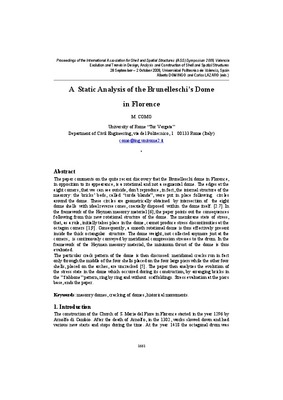JavaScript is disabled for your browser. Some features of this site may not work without it.
Buscar en RiuNet
Listar
Mi cuenta
Estadísticas
Ayuda RiuNet
Admin. UPV
A static analysis of the Brunelleschi's Dome in Florence
Mostrar el registro sencillo del ítem
Ficheros en el ítem
| dc.contributor.author | COMO, M.
|
|
| dc.contributor.editor | Domingo Cabo, Alberto
|
es_ES |
| dc.contributor.editor | Lázaro Fernández, Carlos Manuel
|
es_ES |
| dc.date.accessioned | 2009-12-23T10:20:04Z | |
| dc.date.available | 2009-12-23T10:20:04Z | |
| dc.date.issued | 2009-12-23T10:20:04Z | |
| dc.identifier.isbn | 978-84-8363-461-5 | |
| dc.identifier.uri | http://hdl.handle.net/10251/6783 | |
| dc.description | p. 1661-1674 | en_EN |
| dc.description.abstract | The paper comments on the quite recent discovery that the Brunelleschi dome in Florence, in opposition to its appearance, is a rotational and not a segmental dome. The edges at the eight corners, that we can see outside, don't reproduce, in fact, the internal structure of the masonry: the bricks' beds, called "corda blanda", were put in place following circles around the dome. These circles are geometrically obtained by intersection of the eight dome shells with ideal reverse cones, coaxially disposed within the dome itself. [2.7]. In the framework of the Heyman masonry material [6], the paper points out the consequences following from this new rotational structure of the dome. The membrane state of stress, that, as a rule, initially takes place in the dome, cannot produce stress discontinuities at the octagon corners [1,9]. Consequently, a smooth rotational dome is thus effectively present inside the thick octangular structure. The dome weight, not collected anymore just at the corners, is continuously conveyed by meridional compression stresses to the drum. In the framework of the Heyman masonry material, the minimum thrust of the dome is thus evaluated. The particular crack pattern of the dome is then discussed: meridional cracks run in fact only through the middle of the four shells placed on the four large piers while the other four shells, placed on the arches, are uncracked [5]. The paper then analyzes the evolution of the stress state in the dome which occurred during its construction, by arranging bricks in the " fishbone" pattern, ring by ring and without scaffoldings. Stress evaluation at the piers base, ends the paper. | en_EN |
| dc.language | Inglés | en_EN |
| dc.publisher | Editorial Universitat Politècnica de València | es_ES |
| dc.relation.ispartof | Symposium of the International Association for Shell and Spatial Structures (50th. 2009. Valencia). Evolution and Trends in Design, Analysis and Construction of Shell and Spatial Structures : Proceedings | en_EN |
| dc.rights | Reserva de todos los derechos | en_EN |
| dc.subject | Masonry domes | en_EN |
| dc.subject | Cracking of domes | en_EN |
| dc.subject | Historical monuments | en_EN |
| dc.title | A static analysis of the Brunelleschi's Dome in Florence | en_EN |
| dc.type | Comunicación en congreso | en_EN |
| dc.rights.accessRights | Abierto | es_ES |
| dc.description.bibliographicCitation | Como, M. (2009). A static analysis of the Brunelleschi's Dome in Florence. Editorial Universitat Politècnica de València. http://hdl.handle.net/10251/6783 | es_ES |
| dc.relation.conferencename | Symposium of the International Association for Shell and Spatial Structures | es_ES |
| dc.relation.conferencedate | 2009 | es_ES |
| dc.relation.conferenceplace | Valencia | es_ES |






